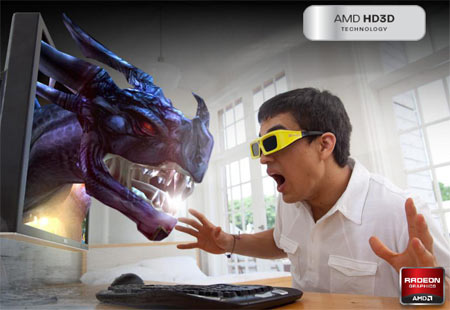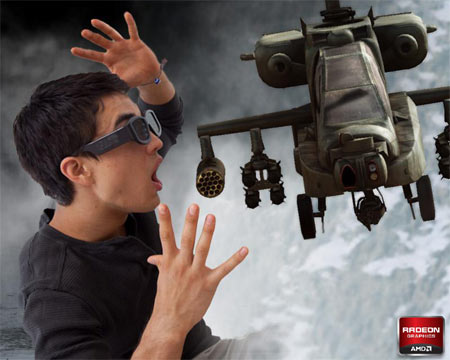AMD Radeon HD 6870 And 6850: Is Barts A Step Forward?
Stereoscopic 3D With AMD’s HD3D
After watching Nvidia build its patented and proprietary 3D Vision empire (the company recently announced that 1000 products are in its ecosystem), AMD is finally engaging the stereoscopic market with its Radeon HD 6000-series GPUs. Up until now, the company has downplayed the significance of and market readiness for this technology. So it's a little surprising to see how much thought has gone into stereo 3D in preparation for the Radeon HD 6800-series.
HD3D is the brand under which AMD is filing its stereoscopic technologies. The company takes a very different approach from Nvidia in that there are no proprietary glasses or specific display technologies associated with HD3D. This presents some interesting advantages and disadvantages compared to Nvidia’s approach.
Pros
Unlike 3D Vision, AMD’s HD3D technology doesn't require a specific display with an AMD-licensed technology built in. Instead, you only need a consumer 3D display that supports HDMI 1.4—a 3D television for example—and plug it into your Radeon HD 6800 series graphics card. From there, it’s up to the software. If you want to play a Blu-ray 3D disc, you’ll need to buy Blu-ray 3D playback software, such as CyberLink’s PowerDVD 10 Ultra or Arcsoft’s TotalMedia Theatre 3. If you want to play games in stereoscopic 3D, you’ll need DDD’s Tridef driver or iZ3D’s driver. With the software installed, your display handles whatever 3D method it’s designed for, whether it uses passive polarized glasses, active shutter glasses, or even glasses-free solutions that might emerge in the future.
AMD demonstrated a number of games and Blu-ray 3D movies at the launch event, using both active and passive glasses technology, but I was curious to see whether or not HD3D is ready for the consumer. A friend of mine has a 120 Hz 3D television, so I paid him a visit to try it out. Using an updated version of PowerDVD 10 Ultra Mark II, I was able to play the Blu-ray 3D movie Cloudy With A Chance Of Meatballs with no fuss whatsoever—it just worked. After this, I installed DDD’s TriDef driver for 3D gaming. Once again, it worked. I expected a lot more of the hassle that generally accompanies an open initiative.
Cons
But it’s also important to recognize the limitations of HD3D. First, there are no dedicated 3D monitors in North America that employ the HDMI 1.4 standard—all of the available 3D monitors at the moment are Nvidia 3D Vision-exclusive, and will not work with the Radeon HD 6800-series cards.
Get Tom's Hardware's best news and in-depth reviews, straight to your inbox.
The good news is that this will probably change now that AMD offers an alternative. But it will take some time. In Europe, the Viewsonic V3D241wm-LED is already available for £330 (about $530 USD) and these were out in force at the launch event. The harsh reality, in the near future at least, is that North Americans who plan to rock a Radeon HD 6800 card on a stereoscopic 3D monitor will have to wait for the displays to arrive. If, on the other hand, you own a commercial 3D television, you can jump right in, though.
In addition, while DDD and iZ3D’s stereoscopic gaming drivers can work perfectly in some situations, our experience has shown us that Nvidia’s 3D Vision driver works better and more consistently in the majority of games. Integration with the GeForce driver also allows for quicker adoption of newer features like DirectX 11, something the other driver developers have traditionally struggled with.
There's one more limitation to bear in mind. Because AMD utilizes the HDMI 1.4a specification, which boasts a maximum TMDS throughput of 10.2 Gb/s, you can either game in stereo at 720p maxing out at 60 frames per second per eye, or you can game at 1080p with up to 24 frames per second per eye. That's actually pretty severe, considering we've been playing around with 5760x1080 using 3D Vision Surround and dual-link DVI connectors (each display running at 1920x1080). AMD says it'll transcend the shackles of HDMI 1.4a next year sometime when monitor vendors begin incorporating DisplayPort 1.2. A peak effective bandwidth of 17.28 Gb/s is enough to enable 1080p at 60 frames per eye.
Nvidia's Answer
It’s important to mention that Nvidia can also handle stereoscopic 3D on commercial displays over HDMI 1.4a with the release of its 3DTV Play driver (perhaps not coincidentally timed for today's launch). This driver is now available as a free download for 3D Vision owners, and will be bundled in a number of products, such as the XPS laptops from Dell. If you want to enable 3D playback on your compatible television, but don't want to buy the 3D Vision kit, the 3DTV Play should be available for purchase from Nvidia.com by the end of November for $39.99. Keep in mind that this driver will work only on newer GeForce models that can handle the HDMI 1.4a standard, such as the GeForce GT 220, GT 240, and the GeForce 400-series. Also note that, if you're using 3DTV Play over HDMI, you'll suffer the same resolution/frame rate limitation as AMD's Radeon HD 6800-series boards. Only by switching to a dual-link DVI output can you overcome that.
With this information in hand, let’s consider costs. If you want to watch Blu-ray 3D, you’re going to have to pay for Blu-ray 3D playback software, regardless of the graphics card. With an Nvidia card, you need to purchase the $40 3DTV Play driver from Nvidia at least or a $200 3D Vision kit at most. The interesting part is that AMD has actually bypassed any proprietary expense, so Blu-ray 3D playback is that much cheaper on Radeon cards.
Having said that, Nvidia includes the stereoscopic game driver with 3DTV Play and 3D Vision, while AMD hardware requires a third party game driver from DDD or iZ3D. These typically cost in the neighborhood of $50 [EDIT: DDD now offers their TriDef gaming driver to Radeon 6000 series owners for $24.99, and iZ3D offers their driver to Radeon 6000 series owners for $19.99]. Aside from cost, Nvidia’s driver solution provides a much smoother overall experience than its competitors--at least right now. Hopefully the extra revenue generated from Radeon HD 6800 owners who invest in these third-party drivers will result in faster development and better results.
Bottom line: with the Radeon HD 6000-series and HD3D, AMD is now offering a viable alternative in the 3D stereoscopic race. For HTPCs attached to commercial 3D televisions, AMD and Nvidia offer surprisingly similar functionality for Blu-ray 3D playback. When it comes to desktop monitor availability and game driver compatibility, Nvidia has a definite advantage, although it no longer enjoys an unassailable position.
Current page: Stereoscopic 3D With AMD’s HD3D
Prev Page Radeon HD 6800-Series Architechture Next Page Morphological Anti-AliasingDon Woligroski was a former senior hardware editor for Tom's Hardware. He has covered a wide range of PC hardware topics, including CPUs, GPUs, system building, and emerging technologies.


